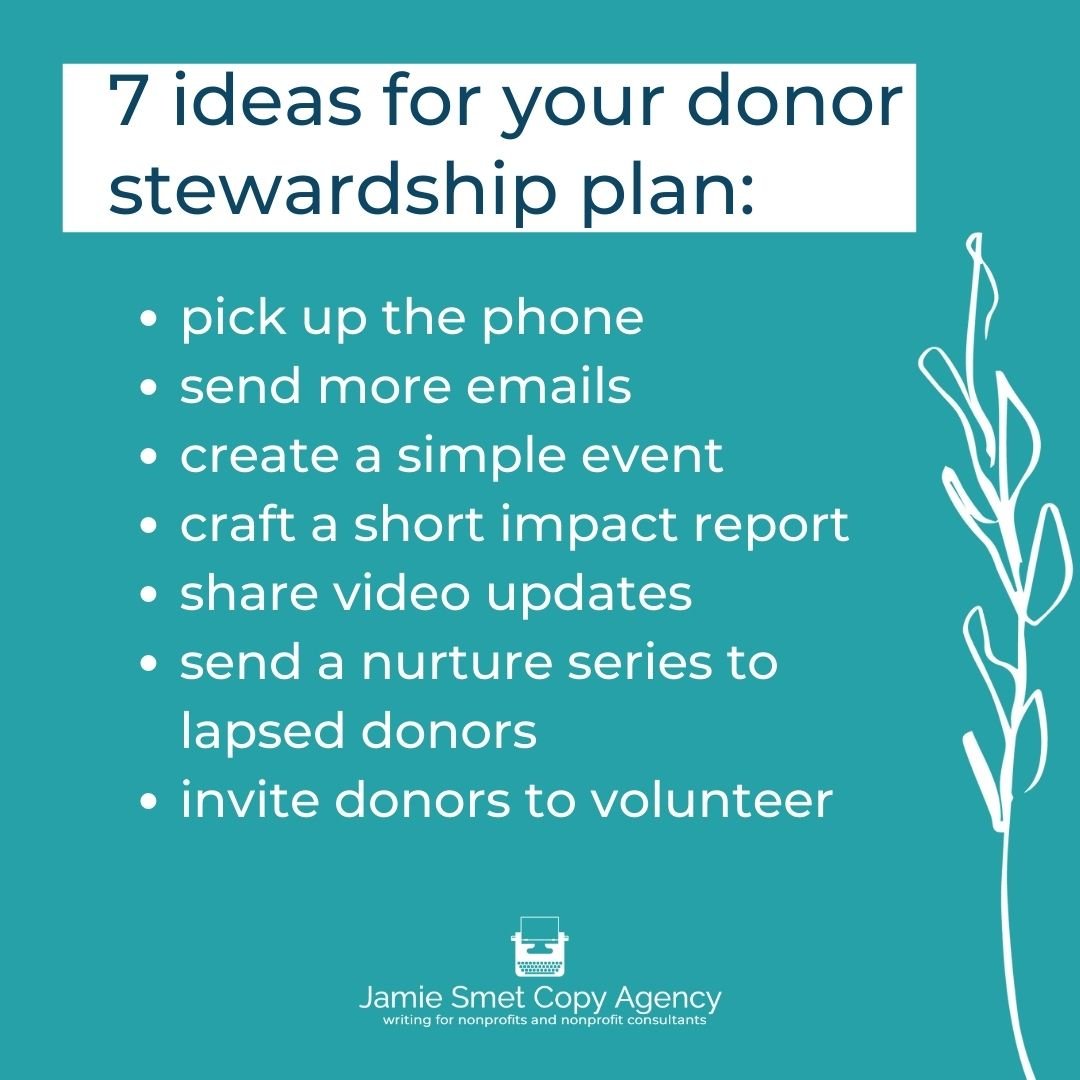Don’t wait until it’s time to ask for money to start thinking about nurturing your donors. Building the relationships that lead to happy, satisfied nonprofit donors is a year-round task. And it requires consistency and authenticity. Keep reading for 7 ideas to make your donors feel special now, so you can raise more money later.
What is donor stewardship?
Donor stewardship is everything you do to care for and deepen – or steward – the relationships you’ve begun with your nonprofit’s donors.
These stewardship activities need to be both genuine and systematic. Like every valuable relationship in your personal life, maintaining it doesn’t just happen. You need to be intentional.
And, similar to your personal relationship, much of donor stewardship is about communication. Donor stewardship involves communicating:
gratitude and appreciation in ways that are meaningful and personal;
impact of the gifts they’ve made;
fiscal responsibility and trustworthiness;
thought leadership that demonstrates competence;
both challenges and successes your organization experiences; and
more opportunities to learn, grow, and make a difference.
Why is donor stewardship so important?
In short, donor stewardship is essential if you want to keep your donors.
According to Nonprofit Pro, most nonprofits lose more than half of their donors each year. Oof, that’s painful.
It’s an incredible waste of your resources and time to find donors, get a donation, and then … have them never give again.
Not to mention the disservice you’re doing to donors by not delivering on the promise you made them when they gave to you.
Year after year donors tell us the same thing.
When they stop giving it’s because:
They weren’t thanked.
They weren’t thanked in a way that felt meaningful to them.
They never heard from you again.
They don’t know how their gift was use – or the difference it made.
Something made them stop trusting your organization.
Donor stewardship is important because you can’t afford to treat your donors like they don’t matter. They have plenty of other options for making the world a better place and feeling good about it. If your organization doesn’t make them feel proud about the difference they’re making, they’ll find a charity that does.
I’ve talked to so many nonprofit leaders who’ve started being consistent about communicating with and caring for their donors and are GOBSMACKED at the difference it makes in their revenue.
Here’s seven ways you can be strategic about stewarding your donors.
7 ideas for your donor stewardship plan:
1. Pick up the phone.
Choose a segment of your donors and reach out by phone. You might have your CEO or Board Chair call all major donors to say thanks and give an update on how their gifts are making a difference.
You might choose to have program staff reach out to your monthly donors to say thank you for being sustainers of the work. Sharing a story from the “front lines” add a powerful touch that brings home the importance of their gift.
Or, highlight your new. Have you reached out to the people who’ve given to you for the first time in the last year? Make a call to say thank you and to see if they have any questions about your work.
Does this take time? YEP.
Is it worth it? ABSOLUTELY.
(And besides improving your revenue and retention, I guarantee you’ll also improve the morale of your team!)
2. Send more emails.
Unless you are already emailing your subscribers weekly, your donors need to hear from you more often.
Put this mantra on a sticky note and keep it close while working on your email communications:
I’m not bugging donors; I’m loving on them.
These nurture emails should be about the work you’re doing and the difference their gifts are making. They should include stories from other donors, volunteers, staff, and beneficiaries. They should provide the opportunity for your donors to learn about your cause and to grow in empathy.
Only about 1 in 5 emails should have a direct ask for money. Are you sending 4 nurture emails for every 1 ask?
3. Create a (simple!) special event.
The goal here is to create a sense of warmth, investment, and community. This isn’t a large-scale fundraising gala that costs lots of money for both your organization and your donors. This is about creating connection, and nobody is asked for money.
Need some ideas?
Throw a picnic for everyone who’s given in the last year.
Offer a behind the scenes tour of your facilities for major donors.
Hold a webinar just for monthly donors, thanking them for their faithfulness and sharing stories of the impact they’re making.
Host a Friday night cocktail mixer for your 20 or 30-something donors.
Provide “lunch and learn opportunities” where experts in various facets of your work share their knowledge. These can be online or in person.
4. Craft a short and sweet impact report.
Annual reports are important, but they often become bloated documents that few people actually read.
A one to two page impact report is a great way to create a visually appealing document that packs a punch.
Using a design tool like Canva makes it easy, too!
For more about these short impact reports, check out this blog post. And here’s a link to one I created for an organization near me.
5. Share video updates from staff.
Informal video updates from a variety of staff are a great way to give donors a sense of connection to your mission and the work you’re doing. With smartphones, making these videos doesn’t have to be a huge time commitment.
You can create videos that are fun and silly or serious and informative. You can use your videos to provide tours of your buildings, to show the behind the scenes of your programs, or to share a heartwarming (or heartbreaking) tale from someone on the “front lines,” or to celebrate successes. The videos make excellent social media or email content.
Ask a staff person who already uses video for their personal social media content to spearhead this. They’ll have lots of ideas and can help you streamline the process.
6. Send a nurture series to lapsed donors/subscribers.
A nurture series for lapsed donors is a 3-5 email series specifically designed to re-engage lapsed donors.
Sending a series like this shows you notice and care when people stop giving. An often unspoken question donors have is, “Does my gift matter?” A nurture series for lapsed donors assures them their gifts matter and that you notice when you stop giving and care about the why behind that decision.
[NOTE: this is not a strategy to use with major givers! They should get a personal touch, like a phone call or coffee date to reconnect. Similarly, monthly donors who end their monthly commitment will ideally also get a personal touch, to say thank you and ask them about their decision to end their monthly gift.]
Your nurture series should have a few key elements:
You want to say thank you for their past generosity.
Provide updates about the work you’re doing and the impact that donors make.
Ask them to make another gift.
Give them the opportunity to opt-in (or out) of receiving further communications from you – and to share feedback about why they’ve stopped giving.
7. Invite donors to participate in a low-key volunteer opportunity.
Inviting donors to volunteer is an excellent way to nurture them and to help them develop deeper bonds with your work – and your staff!
Where I see many nonprofits flounder with this idea, though, is in their inability (or unwillingness) to be hospitable to their volunteers. Too many organizations don’t think through how they can ensure that volunteers have a great experience.
Think carefully about the onboarding process for new volunteers and plan for every stage of their experience.
Send clear communication about what to expect when they volunteer. Greet them when they show up. Introduce them to key people. Make sure they know what you’d like them to do. Check in regularly to make sure it’s going ok. Thank them before they leave, and then again by email later.
Free download: 10 ideas for your donor stewardship plan
Download the doc for a handy-dandy list of these 7 ideas (PLUS+ 3 bonus ideas!) to rev up your donor stewardship strategy.
Wouldn’t it be great to head into your next fundraising appeal knowing your donors feel appreciated and engaged with your work?
NEED HELP STEWARDING YOUR DONORS THROUGH EMAIL?
Schedule a free call today to start nurturing and retaining your donors.
You might also like:







